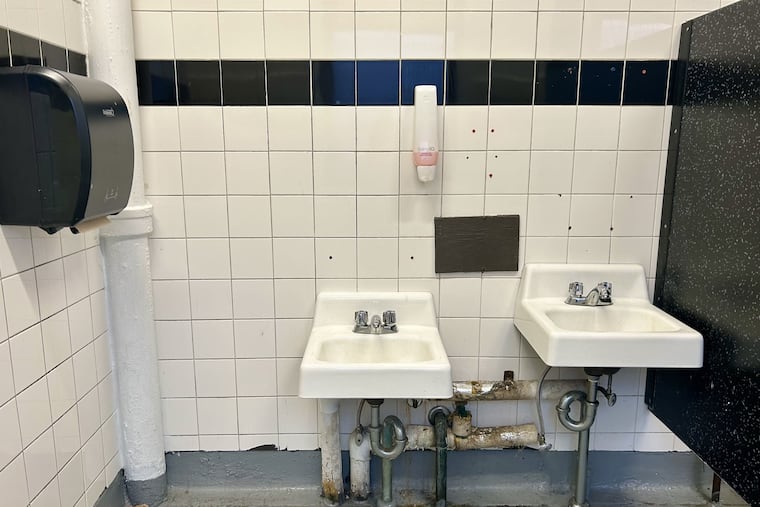Philly school bathrooms take 50 days to fix when broken. Here’s how that looks from the inside.
Broken restrooms take 50 days to get fixed. Meanwhile, students hold their nose and their waste.

Jayla Gattis avoids using the bathroom at school whenever possible.
“The smell is often very, very bad, and there was this one stall that was broken for a week,” said Gattis, 16, a junior at Sayre High in West Philadelphia.
In the Philadelphia School District, it took, on average, 50 days for a broken bathroom to get fixed last school year, up from 38 days the year before. The 216-school system has more than 2,000 bathrooms in its large stock of old buildings but employs just eight plumbers — the district has a 62% vacancy rate on plumbing positions.
That means the district’s bathrooms are too often broken, missing supplies or just plain disgusting, said Gattis and Solomen Georges, another Sayre junior.
“Sometimes the toilets just don’t flush, and one of the urinals was broke for a week,” said Georges, 17. (He’s also grossed out by the roaches, mice, and other vermin frequently spotted around the school, but that’s a separate issue.)
“It makes me feel like they don’t care about us,” said Gattis.
‘It’s hard to imagine’
Philadelphia schools have been underfunded for decades — a state court this year declared Pennsylvania’s education funding system illegal, and ordered it changed — and facilities woes are one by-product of the inadequate revenue stream.
The problems are not universal; some students and teachers reported bathrooms that are routinely clean and well-maintained, even in old buildings.
In any case, district officials have said that the bathroom conditions must improve.
“It’s hard to imagine those kinds of inadequate facilities in the schools,” school board member Joyce Wilkerson said at a meeting this month. “It doesn’t send the kind of messaging or feeling we want for students in our schools. I think this is a subject we need to be moving more aggressively on.”
Superintendent Tony B. Watlington Sr. was alarmed that the district is “getting worse, not better at this” and vowed at the meeting that the district, which supplements its own trades workforce with outside contractors, would examine best practices around work orders in other large school systems, and use career and technical education programs to bolster the ranks of plumbers and other workers. The district would also better communicate its needs and expectations to school communities around bathroom issues.
No doors, bad smells
Trina Dean knows Philadelphia schools well, as a parent — her son is a seventh grader at Greenberg Elementary in the Northeast — and as a district academic coach, working in many schools.
Bathroom conditions are a widespread problem, she said.
“At a lot of schools, there’s missing stalls, no doors on stalls,” said Dean. “Cleanliness is another thing; you shouldn’t smell a child’s bathroom from all the way down the hall, but you do — a lot of them smell horrible.”
Dean’s son often races for the bathroom as soon as he walks in the door from school, she said.
“He literally comes home and I don’t want to be vulgar, but he waits to go the bathroom till he comes home, because the bathrooms are in bad shape at school,” said Dean.
» READ MORE: A $6.9 million sexual-abuse settlement and a new charter application: Philadelphia school board roundup
Dean, like many others interviewed, said she knows the cleaning and facilities staff work hard and do the best they can with the limited resources they have.
But, she said, she’s frustrated when she goes to the district’s Center City headquarters and sees well-stocked bathrooms free of odors.
“It says something about how we value our kids,” said Dean.
At one Northeast elementary school with a booming population, the bathrooms don’t always meet kids’ needs, a teacher said.
“There’s often broken stalls, they don’t have a door, or they don’t have basic things like a toilet paper dispenser,” said the teacher. “Things don’t get replaced as quickly as they need.”
Sometimes, students won’t wash their hands because there’s no soap or paper towels, said the teacher, and sometimes, they’ll make messes.
“It feels like there’s not much of a standard for the bathrooms,” she said. “The kids don’t feel respected, so they trash them sometimes.”
Flushing toilets at Benjamin Franklin Elementary in Lawncrest can be a process: The handle might not go all the way down, and even if it does, it might require several tries to successfully flush waste, said a staffer at the school, who asked to remain anonymous for fear of reprisal.
In addition to flushing problems, faucet water comes out brown, said the staffer, who reported the problem but has seen no resolution.
Then there’s the problem of staff bathrooms, where locks were removed because a student once got stuck inside. Since there are no stalls, just a single toilet, there’s no guarantee of privacy. (Student bathrooms have stalls with locks that usually work, the staffer said.)
At Benjamin Franklin, students “complain a lot about our bathrooms — they don’t work, they don’t flush, they’re not clean, they don’t want to use them,” said the staffer. The school has about 700 students but has had trouble keeping building engineers and has been relying on trainees and assistants to perform the work instead.
Masterman, where 17-year-old Nicolas Dorazio is a senior, also has a jam-packed building and bathrooms that aren’t always in ideal shape.
“We’ve had some difficulties with stocking products; sometimes, bathrooms will go for days on end without soap or paper towels,” said Dorazio.
And the smell?
“I’ve kind of adopted this habit of not breathing through my nose whenever I step into the bathroom,” Dorazio said. “I try not to touch any surfaces. I know we’re relatively privileged to have at least functioning bathrooms, but there’s clear work that could be done.”